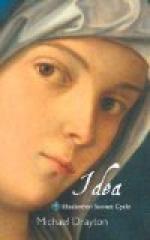Idea’s Mirrour, Amours in Quatorzains, formed the title under which the sonnet-cycle appeared in 1594. Idea was reprinted eight times before 1637, the edition of 1619 being the chief and serving for the foundation of our text. Many changes and additions were made by the author in the successive editions; in fact only twenty of the fifty-one “amours” in Idea’s Mirrour escaped the winnowing, while the famous sixty-first appears for the first time in 1619. There is a distinct progress manifest in the subdual of language and form to artistic finish, and while the cycle in its unevenness represents the early and late stages of poetic progress, the more delicate examples of his work show him worthy of the praise bestowed by his latest admirer and critic,
“Faith, Michael Drayton bears
the bell
For numbers airy.”
It will be noted that, while many rhyme-arrangements are experimented upon, the Shakespearean or quatrain-and-couplet form predominates. In the less praiseworthy sonnets he is found to lack grammatical clamping and to allow frequent faults in rhythm, and he toys with the glittering and soulless conceit as much as any; but where his individuality has fullest sway, as in the picturesque Arden memory of the fifty-third, the personal reminiscences of the Ankor sonnets, and the vivid theatre theme of the forty-seventh, in what Main calls that “magical realisation of the spirit of evening” in the thirty-seventh, and above all in the naive and passionate sixty-first, there is a rude strength that pierces beneath the formalities and touches and moves the heart. Drayton, like Sidney and Daniel and Shakespeare, draws freely upon the general thought-storehouse of the Italianate sonneteers: time and the transitoriness of beauty, the lover’s extremes, the Platonic ideas of soul-functions and of love-madness, the phoenix and Icarus and all the classic gods, engage his fancy first or last; and no sonnet trifler has been more attracted by the great theme of immortality in verse than he. When honouring Idea in the favourite mode he cries




